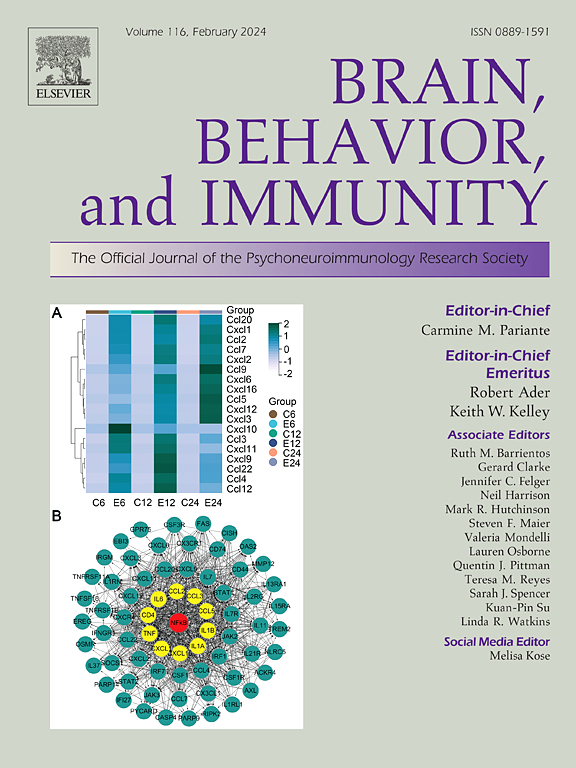Associations between childhood maltreatment, peripheral immune biomarkers, and psychiatric symptoms in adults: A cohort study of over 138,000 participants
IF 8.8
2区 医学
Q1 IMMUNOLOGY
引用次数: 0
Abstract
Background
Few studies have integrated the impact of individual and cumulative childhood maltreatment on multiple psychiatric symptoms, with the mechanisms underlying these associations largely unknown. This study aims to comprehensively assess the associations between childhood maltreatment, multiple peripheral immune biomarkers, and various psychiatric symptoms in adulthood and to explore whether peripheral immune inflammation plays a mediator role in the associations between childhood maltreatment and psychiatric symptoms in adulthood.
Methods
Using data from the UK Biobank, we constructed a retrospective cohort study of 138,915 participants who provided self-reported childhood maltreatment and had peripheral immune biomarkers assessed. We examined seven types of psychiatric symptoms in adulthood, including depressive symptoms, anxiety symptoms, mania, post-traumatic stress disorder (PTSD), psychotic experiences, self-harm, and alcohol use disorder. Logistic regression models were performed to explore the associations between childhood maltreatment, immune biomarkers, and psychiatric symptoms, calculating the average marginal effects for each indicator of childhood maltreatment. Mediation analyses were conducted to determine the extent to which the immune biomarkers could explain the association between childhood maltreatment and psychiatric symptoms in adulthood. Subgroup and sensitivity analyses were also performed.
Results
Among the participants, 77,937 (56.10 %) were female, with a mean age of 55.91 (SD: 7.73) years at baseline. There were dose–response relationships existed between the accumulation of childhood maltreatment indicators and all seven assessed psychiatric symptoms and multimorbidity in adulthood (e.g., for depressive symptoms, OR = 1.67 [95 %CI, 1.57 to 1.78] for one childhood maltreatment indicator; OR = 2.77 [95 % CI, 2.58 to 2.97] for two; OR = 4.91 [95 % CI, 4.61 to 5.24] for three or more). Emotional abuse and physical neglect showed the strongest average marginal effects on psychiatric symptoms. Levels of C-reactive protein (CRP) and counts of leukocytes and neutrophils were positively associated with depressive symptoms (e.g., OR = 1.13 [95 % CI, 1.08 to 1.17] for CRP level), anxiety symptoms, PTSD, and psychotic experiences. Moreover, levels of CRP partially mediated the association between childhood maltreatment scores and psychiatric symptoms, albeit with a relatively low mediation proportion (0.65 %-1.77 %).
Conclusions
Our findings underscore the importance of interventions that address multiple forms of childhood maltreatment to mitigate long-term mental health challenges substantially. While peripheral immunity responses may serve as predictors of mental health problems, they might not to be the primary mechanism through which childhood maltreatment influences psychiatric symptoms in adulthood.
童年虐待、外周免疫生物标志物与成人精神症状之间的关系:对超过 138,000 名参与者进行的队列研究。
背景:很少有研究综合了个体和累积的童年虐待对多种精神症状的影响,这些关联的内在机制在很大程度上也是未知的。本研究旨在全面评估童年虐待、多种外周免疫生物标志物与成年后各种精神症状之间的关联,并探讨外周免疫炎症是否在童年虐待与成年后精神症状之间的关联中起中介作用:我们利用英国生物库的数据构建了一项回顾性队列研究,研究对象为138,915名自我报告童年遭受虐待并接受外周免疫生物标志物评估的参与者。我们研究了成年后的七种精神症状,包括抑郁症状、焦虑症状、躁狂症、创伤后应激障碍(PTSD)、精神病性体验、自残和酒精使用障碍。为探讨童年虐待、免疫生物标志物和精神症状之间的关联,我们建立了逻辑回归模型,计算了每个童年虐待指标的平均边际效应。我们还进行了中介分析,以确定免疫生物标志物在多大程度上可以解释童年虐待与成年后精神症状之间的关联。此外还进行了分组分析和敏感性分析:参与者中有 77,937 人(56.10%)为女性,基线平均年龄为 55.91 岁(标准差:7.73)。童年虐待指标的累积与所有七项评估的精神症状以及成年后的多病症之间存在剂量-反应关系(例如,就抑郁症状而言,一个童年虐待指标的OR = 1.67 [95 % CI, 1.57 to 1.78];两个指标的OR = 2.77 [95 % CI, 2.58 to 2.97];三个或更多指标的OR = 4.91 [95 % CI, 4.61 to 5.24])。精神虐待和身体忽视对精神症状的平均边际效应最强。C反应蛋白(CRP)水平以及白细胞和中性粒细胞计数与抑郁症状(例如,CRP水平的OR = 1.13 [95 % CI, 1.08 to 1.17])、焦虑症状、创伤后应激障碍和精神病经历呈正相关。此外,CRP水平对童年虐待评分与精神症状之间的关联起到了部分中介作用,尽管中介比例相对较低(0.65%-1.77%):我们的研究结果凸显了针对多种形式的儿童虐待进行干预的重要性,以大幅减轻长期的心理健康挑战。虽然外周免疫反应可能是心理健康问题的预测因素,但它们可能并不是童年虐待影响成年后精神症状的主要机制。
本文章由计算机程序翻译,如有差异,请以英文原文为准。
求助全文
约1分钟内获得全文
求助全文
来源期刊
CiteScore
29.60
自引率
2.00%
发文量
290
审稿时长
28 days
期刊介绍:
Established in 1987, Brain, Behavior, and Immunity proudly serves as the official journal of the Psychoneuroimmunology Research Society (PNIRS). This pioneering journal is dedicated to publishing peer-reviewed basic, experimental, and clinical studies that explore the intricate interactions among behavioral, neural, endocrine, and immune systems in both humans and animals.
As an international and interdisciplinary platform, Brain, Behavior, and Immunity focuses on original research spanning neuroscience, immunology, integrative physiology, behavioral biology, psychiatry, psychology, and clinical medicine. The journal is inclusive of research conducted at various levels, including molecular, cellular, social, and whole organism perspectives. With a commitment to efficiency, the journal facilitates online submission and review, ensuring timely publication of experimental results. Manuscripts typically undergo peer review and are returned to authors within 30 days of submission. It's worth noting that Brain, Behavior, and Immunity, published eight times a year, does not impose submission fees or page charges, fostering an open and accessible platform for scientific discourse.

 求助内容:
求助内容: 应助结果提醒方式:
应助结果提醒方式:


